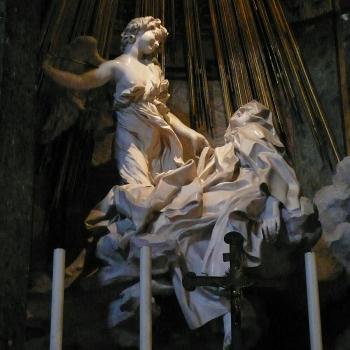This past Saturday a small band of weirdos met in a park to practice our chant, then headed to the Cloisters to do some guerrilla venerating. Our pilgrimage made me think about relics; and about public witness, and the relationship between these two aspects of Christian practice.
The Cloisters, like many other museums, holds certain real relics, including a relic of the True Cross. First of all, relics should be venerated not merely appreciated; second of all, relics should not be paywalled. It costs $25 for a non-New Yorker to go and venerate these relics, which should be open to all. Did Christ give His life only for those with twenty-five bucks to spare? He did not.
So we went, and those of us from out of town paid our museum-simony, and we found the True Cross relic and began to quietly pray an Office. We were swiftly interrupted by a security guard, who told us that people had complained and were “offended.” (I don’t know if this word was theirs, or his translation of their concerns, or what.) Like a complete idiot I attempted some negotiation, which first of all wasn’t my place as I had no actual authority in this pilgrimage, and second of all was dumb because the safe employee-answer to any question of the form, “But can we…?” is, “You sure can’t.”
We were not allowed to finish praying in the garden, but we did kneel and pray silently for about a minute, under the eyes of the security guard, who let us do that. I’m sorry to say only one of us (not me) remembered to thank him btw. I am always better at the theory of deliberate humiliation than the practice. After that we prayed silently, standing before one of the altars which may still have its altar relics, then did a quick prayer before an altar which almost certainly doesn’t, and then finished the Office outside. The guard followed us for a while (and possibly thought we were trying to give him the slip when in fact we were just lost).
We prayed a rosary en route to the Met. The subway straphangers ignored us, they’ve seen weirder sights. But as we were walking along the edge of (I think) Central Park, praying a litany of the saints, we passed a Jewish family. The father listened keenly to our prayers to the saints whose relics we were visiting (“St Valentine, pray for us…”) and then mixed in with, “St. Moses!”
“Pray for us!” we replied in chorus.
Then one of the other pilgrims of Jewish origin exchanged “Gut shabbes” with him. I was delighted by this echt New York experience and I am pretty sure that is how the paterfamilias was feeling as well.
Before hitting the Met we received a blessing from a random Dominican we wandered across. Then we planned! We didn’t plan enough before the Cloisters, we figured, so this time we would plan. Here’s what we’ll do when (not if) the security guard comes; here’s who will speak for us. (I do think we were smart to pick the shortest, sweetest lady in our group for this task.)
As always man plans, God laughs. In the chaos of the Met nobody cared that we were praying! Admittedly we were also quieter–at the Cloisters we’d started out quite soft and then gotten to a somewhat bolder muttering, still not “loud” imo but definitely above the collective reverent whisper we achieved at the Met. I mean our purpose was not to mess up anybody’s planned outing or tour, you know? But even when we were all kneeling in front of a relic of the True Cross, at the Met nobody cared. The group proceeded to the Morgan Library but I had to peel off at this point, so I can only reflect on what happened up to here.
First of all, until Saturday nobody had ever asked me why Catholics venerate relics. When one of our group asked this, I had to pause. I’ve always loved the whole relic deal, even before I was Catholic; I’ve loved reliquaries since high school, the gothic bone-love, the haunting adornment of our wreckage. So I never bothered to ask why we did it. It honors the body and it’s hardcore (my greatest term of praise), what more do you need?
But on this pilgrimage I found myself thinking that we venerate relics to proclaim, in awe and gratitude, that no act of cruelty, abuse, or oppression can take away the goodness and beauty with which our Creator made our bodies. Tyrants wanted the martyrs’ bones to proclaim the tyrants’ power. Veneration of the relics speaks the truth: that martyrs’ bones proclaim the power of God, and His love for His murdered children. The True Cross might be the most powerful example here. Men tried to make this tree speak of Jesus’ defeat, and yet its very wood is His creature and proclaims His triumph.
Whatever wrong we do with our bodies, and however others try to use our physical vulnerability to destroy us, our bodies remain God’s beautiful and good creation. The great saints sinned with their bodies, as all of us do except Christ and Our Lady, and yet those sins don’t define their bodies. Truly even their virtues don’t define their bodies; their virtues are simply the places where their wills became so transparent that God’s love could be seen shining through.
I don’t know to what extent our outlaw pilgrimage proclaimed these truths. The veneration was good in itself! What about the public witness?
It seems like the closest we came to an ideal moment of public witness (as far as we know–obviously God does all kinds of wacky things in people’s hearts) was the prayer to St. Moses. The Jewish father wasn’t threatened by our prayer; he understood what we were doing, and recognized in it certain truths to which he also could respond with joy; and he felt a kind of ownership, a right to the situation which led him to stick his oar in. He took our witness as an invitation, not an exclusion.
I suspect at the Cloisters, at least to the people who complained, we came off as excluding rather than inviting. “You think these beautiful objects belong to everybody but they really belong only to Christians, not to you,” perhaps, instead of our intended message, “We act like these holy relics belong to museums and their paying patrons but they really belong to God and His people, which is everybody.” Now, in all situations I would argue you should talk directly to the people bothering you instead of involving an authority figure, but people also react to new situations based on what they know of prior ones. In high school, as much as I loved reliquaries, my main exposure to “Christian public witness” was the people who screamed at Pride parades with signs saying we were going to Hell. I don’t know how I would have interpreted a bunch of people kneeling before a reliquary. Would it have seemed kind of awesome or poignant to me, that they think it’s real? (Like the lady who holds up her baby to see the unicorn, with her false horn glowing, in The Last Unicorn. All the better parallel in that it’s a real unicorn!) Or would it have been threatening, an attempt by Christians to take over a place where I’d felt that I belonged? If it’s the former, is that only because my own experiences of Christian power and exclusion were (at the time!) so abstract and distant?
Relics proclaim that our bodies belong to God, not to those in power. Powerful people may destroy our bodies but they can’t destroy our bodies’ meaning or beauty; we ourselves may use our own power to misuse our bodies, in gluttony or sexual sin or self-harm, but we can’t excise our own created beauty. The scarred wrist, as much as the martyr’s skull still gashed by the axe, still holds the beauty God has given us: an inalienable beauty.
And the pilgrimage to hostage relics was also about this question, to whom do our bodies–and all the beauty of the created world–belong? There are a lot of ways museums could release their hostage relics. They could take the relics out, give them to the Church, and keep the beautiful reliquaries. They could make the reliquaries available for free, in a separate room, or once a month or something, for veneration. (Years ago I read in a guidebook that if you go to the Tower of London and say you’re a Catholic who wants to pray at St Thomas More’s cell, the guards will let you up. For free? Probably not. It should be for free.)
My preferred solution would be straight-up giving the relics, in their beautiful houses, to Catholic churches. This would put the reliquaries “in context”–in roughly the setting for which they were made. It would also, of course, sharpen the question of belonging. On the one hand it may seem like a claiming of beauty for Christians against secular people: This beauty isn’t for you! Which is false. On the other hand, I’ve seen lots of visibly poor and homeless people in churches. Even though the art museums here in DC are mostly free, I’m not sure I’ve ever seen anybody inside them whom you could guess might be homeless. Nobody with their belongings in bags, nobody sleeping on the benches, nobody whose poverty has affected their clothing or hygiene or teeth. If churches exclude on a psychological level, creating an unease or feeling of alienation in non-Christians, it seems fairly clear that museums also have a culture in which some belong and others don’t.
Beauty belongs first to God. Then to everyone. Then to the poorest. Last of all to the rich and powerful.
This is one part of what we were trying to say with the pilgrimage–or what I was trying to say, anyway. I don’t know that we conveyed that, and while I hope this idea spreads to other cities (DOOOOOOO IIIIIIIIIIIIT) I also hope you all figure out better ways to make this form of witness as much invitation as rebuke.
Picture of a head-shaped reliquary via Wikimedia Commons.












